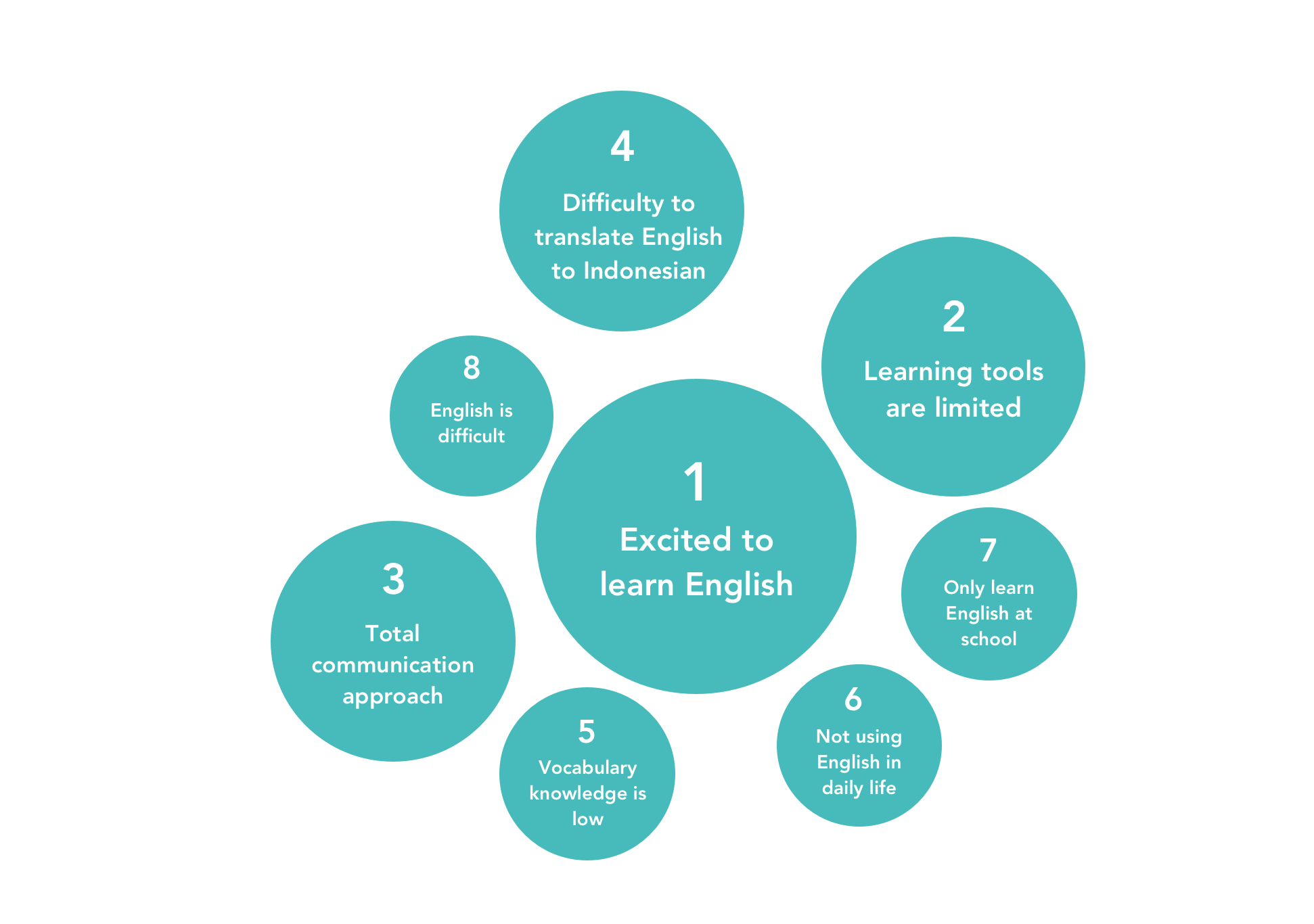How do students with hearing impairments learn new language - a language that is not even their native? TalkinEnglish is a mobile app to help Indonesian students learn English through lip reading and sign languages. More than 60% of the students at SLB Cicendo School For the Deaf were motivated to learn English as their third language.



The story
According to initial observation and interview in SLB-B Cicendo Bandung, one of the schools for disabled students with hearing loss in Indonesia, 74% of the students recognized it was very hard to learn English. However, 84% of them were indeed interested to learn it. They had been understood the importance of learning English because they wanted to communicate with foreigners. The biggest difficulty for them in learning English was the differences between pronunciation and spelling.

For students with hearing impairments, the biggest challenge to learn English as tertiary language was the differences between pronunciation and spelling.
User research
Students were really interested and excited to learn English because they understood the importance of it. However, the learning tools for them to be able to learn English were limited. They couldn't really use some basic tools that other students could use since total communication was really important for them. They had to incorporate all means of communication: formal signs, natural gestures, lipreading, listening, etc. As a tertiary language, English was not really used in their daily life. That's why they still found it was hard to understand.

Design objectives
I did some user researches to know exactly what users needed. Based on qualitative researches directly to real users, below is the insights about what students needed:
- An educational media to help students with hearing impairments to learn English.
- It had to acquaint new English vocabulary, grammar, and syntax.
- The interface should be visually appealing, to improve the visual interest.
- It had to facilitate students to learn English easier.
The proposed user goals and tasks are needed to make the students more enthusiastic in learning English and to get user accustomed in using English.

Gamification
After doing many qualitative user research, I noticed that students loved to play games, physically or digitally. Even though they had hearing problems, but it didn't stop them from using technologies such as smartphones and computers. They needed more time to learn it, but they had fun once they knew how to use it. To make it more playful and engaging, I used gamification as the conceptual model: a Pop Quiz to learn English in a simple form relating to their everyday life.

The Content Page consisted of 3 different levels:
- Basic
- Intermediate
- Advance
Each level had 5-10 categories. The difficulty and categories of each level were mapped from students' English curriculum in class. I studied the teaching curriculum specifically in English course for elementary until high school to get the contents that would fit for the users.

Mobile app design
The faster the design could be tested, the faster we got feedback from the real users. That said, I created a low-fidelity prototype using papers before investing my time to develop a working prototype. Paper prototyping was really effective and efficient in terms of time and cost. It was an ideal solution to test whether the concept worked or not.
There were 3 iterations in total before I developed the app. I also created a high-fidelity prototype using Principle so that the users knew exactly how to interact with it.

The app was developed using Ionic Framework, a complete open- source SDK for hybrid mobile app development. It was built on top of AngularJS and Apache Cordova. The development was using web technologies: HTML5, Sass, and AngularJS. I decided to use web app so that it could be developed in both iOS and Android.

Users were able to track their progress on Home (Learn) Page. This would encourage users to learn more, since there was a reward (badge) after they completed a category in each level.

Total communication was an effective way for students with hearing impairments to learn new language. In this app, users could learn from lipreading and sign language at the same time.

The learning concept was an understandable pop-quiz. Pop-quiz was really effective to train users memories. I also had to design it in a playful way to engage users.
Success measurement
After the development phase, I still had to do usability testing to know if the user goals were achieved or not. The usability testing was moderated-in-person, with 1 user and 2 testers: a person as an observer and another one gave the instruction, with the scenario:
- Pre interview: The initial interview was done to perceive information of how users learn English generally.
- Exploration: Users were given 3 minutes to explore the prototype. It was a stage to familiarize the prototype to users.
- Tasks completion: After users explored the prototype, they had to complete several tasks to measure the usability goals and user experiences.
- Post interview: The post interview was done to get direct insights of how users experienced the prototype.
- Questionnaire: The questionnaire was done to gather quantitative data.

The success rate was determined by quantitative research after usability testing was done. There were 2 main categories: User Experience and Usability Goal. For User Experience, users were asked if the app was appealing, helpful, motivating, and had a good User Experience. Meanwhile, the Usability Goal was determined if the app was learnable, likable, useful, and effective.

The impact
After I tested TalkinEnglish with students, the result showed that most of the proposed user experiences were accomplished, 3 out of 4 user experiences were achieved. Students considered that it was helpful and they were motivated while using the app. Most of the proposed usability goals also had been accomplished. The result in figure above shown that the prototype was useful, effective, and liked. More than 60% of users rated 4 for each component.



